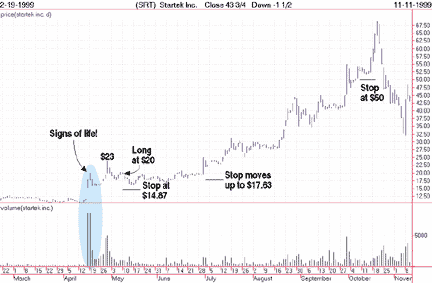MONEY MANAGEMENT
Risk Management In The Real World
by Ajay Jani
An experienced trader takes his lumps in the market, but still comes out ahead. How? Prudent risk management.
In order to generate long-term investment success, traders must adhere to several time-honored trading principles. Bruce Babcock summed up these principles concisely in his Four Cardinal Principles Of Trading:
1 Trade with the trend.
2 Cut losses short.
3 Let profits run.
4 Manage risk.
 |
FIGURE 1: STARTEK (SRT). After trading below $15 for nearly two years, Startek began to show signs of life early in 1999.
No trading methodology is 100% accurate. Thus, it is important not to place all of your capital at risk on any given idea. When an idea is correct, you must let it work as long as possible to generate the large returns necessary in order to offset the inevitable losing trades. Here are some real-life examples of both winning and losing trades, and how my risk management of these trades resulted in overall profitable trading, even though 50% of the trades resulted in losses.
STARTEK
Startek (Figure 1) began to show signs of life early in 1999 after trading below $15 for nearly two years. A high-volume spike to the $23 level was followed by consolidation on declining volume. This looked like the first leg of an explosive move, and during the consolidation, I purchased shares at $20, with an initial stop-loss set at $14-7/8. I set the position size so that if I were stopped out, the net loss to my capital would be 1%. The calculation to determine the correct position size for a given portfolio size and risk tolerance is:
(Portfolio size)*(Risk tolerance) / ABS (Entry - stop)
Ajay Jani has worked in the securities business since 1988. He currently trades emerging market debt for a European investment bank in London. He can be reached at columbiatrading@aol.com.
Excerpted from an article originally published in the June 2000 issue of Technical Analysis of STOCKS & COMMODITIES magazine. All rights reserved. © Copyright 2000, Technical Analysis, Inc.
Return to June 2000 Contents